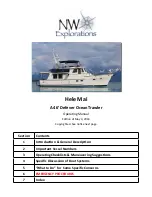
2005
MASTERCRAFT
OWNERS
MANUAL
–
PAGE
19-1
MAINTENANCE
U N S C H E D U L E D
> > > > >
Propeller damage is caused by striking solid objects. If the propeller is not rotating at the time it strikes a solid object, the
damage is usually confined to just one blade and may be difficult to see. If the propeller is rotating when it strikes an object,
usually damage can easily be seen on all blades.
CHECKING/REPAIRING
PROPELLERS
Step 1: Ensure the engine is OFF and the engine safety start-
ing switch disconnected. Place the throttle/shift control lever
in forward gear.
Step 2: Clamp a small rule scale to the shaft strut, parallel to
the shaft so that the end of the scale is 3/32-inches from the
leading edge of a propeller blade.
Step 3: Rotate the propeller slowly. There should be no more
than 3/32-inch variance between the blades. If the propeller is
damaged, see your MasterCraft dealer.
To repair minor nicks and dings in a propeller (MasterCraft
makes no claims to this methodology)
Step 1: Remove the propeller from the boat.
Step 2: Use a small ball-peen hammer and anvil to carefully
straighten out the ding to the original contour of the blade.
Step 3: File the area to remove rough edges.
Step 4: Re-install as outlined in Changing Propellers instruc-
tions. If a vibration is detected, have the propeller replaced. Do
not use a propeller that is the source of a vibration. Further
drive-train damage could result and this will not be covered
under warranty.
CHANGING
PROPELLERS
Step 1: Ensure the engine is OFF and the engine safety start-
ing switch disconnected. Place the throttle/shift control lever
in forward gear.
Step 2: Remove and discard the cotter pin.
Step 3: Remove the propeller nut.
Step 4: Tap the center hub of the propeller with a rubber mallet
to release the propeller. Inspect the shaft and propeller splines
for damage.
Step 5: Thoroughly clean and apply a light coat of waterproof
marine multi-purpose grease to the splined area of the shaft
and propeller.
Step 6: Align the splines and carefully install the propel-
ler onto the shaft. DO NOT FORCE IN PLACE.
Step 7: Install the propeller nut and torque to 50-ft-lbs.
Step 8: Install a new cotter pin and bend the ends around the
shaft to lock the propeller on the shaft.
CHECKING
SPEEDOMETER
CALIBRATION
For tournament use and practice, accurate speedometer
readings are a must. To calibrate the speedometer you need an
accurately measured course of 850 feet and a certified stop-
watch accurate to a thousandth of a second. To calibrate to
AWSA official-tournament rules:
Step 1: Approach the course at an indicated 36 miles per
hour (MPH). Hold the speed steady and have an observer
check the course time with a stopwatch.
Step 2: If the course time is between 15.88 and 16.28 seconds,
no adjustment is necessary. If the course time is not within
tolerance, the adjustment switch is on the lower right panel of
the dash.















































